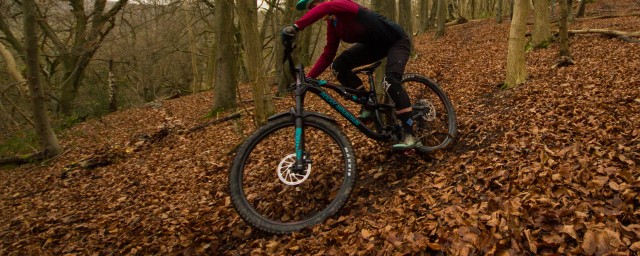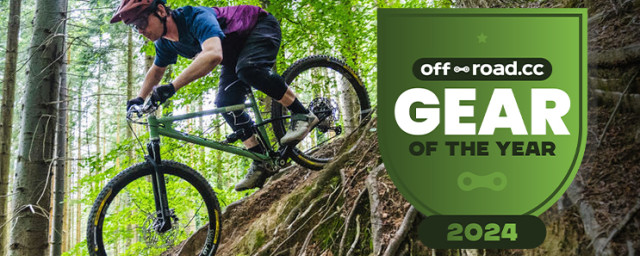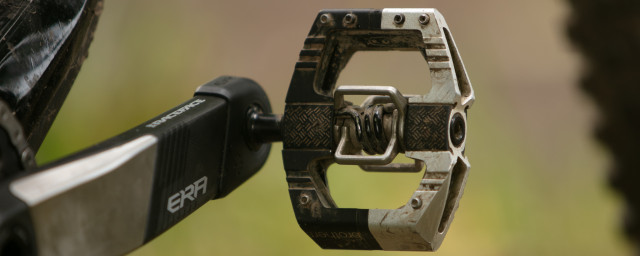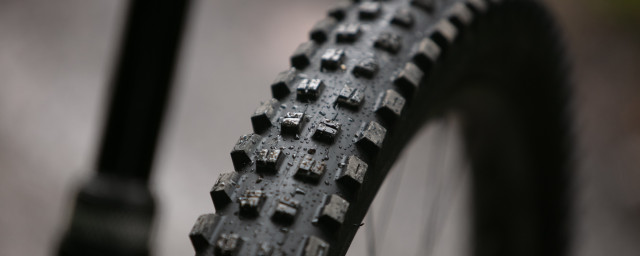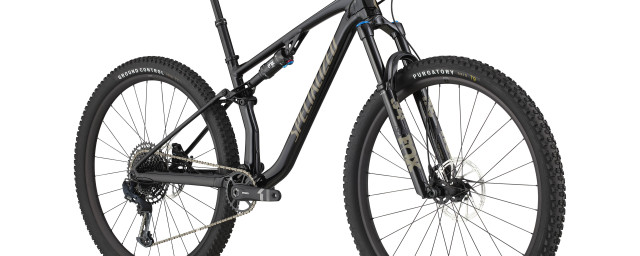Talking disc brake technology with SRAM
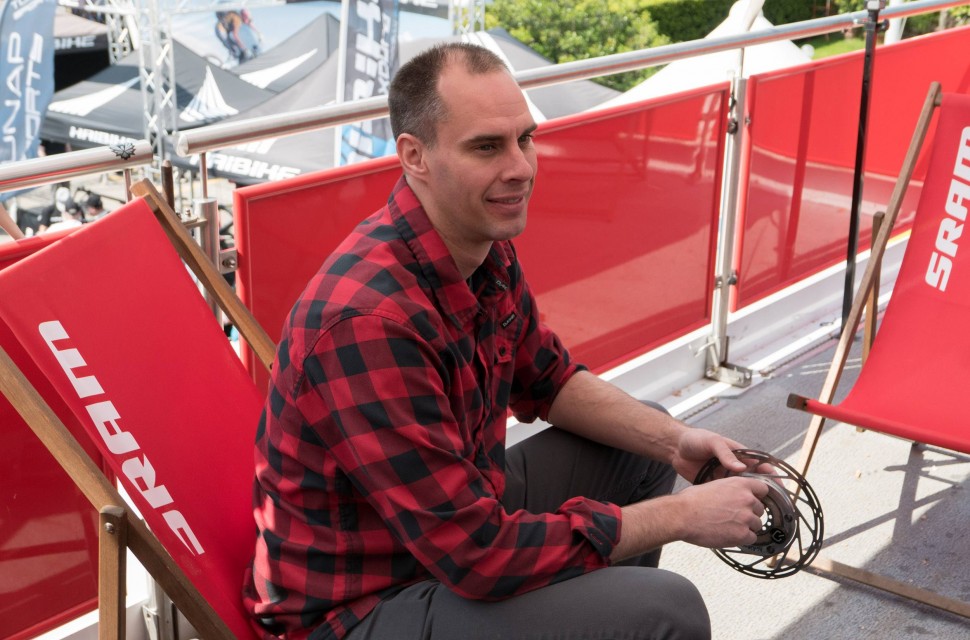
Most brands test their brakes using a large, powerful static rig, whose sole purpose is to spin things very fast until they glow red or catch on fire. That's fine for finding out how well a pad wears or how hot a brake can get before failing, but it's not so good for telling you how people use their brakes in the real world.
- Which disc brake pads are best for mountain bikes? Sintered or organic?
- Your complete guide to the RockShox fork range
- The best Marzocchi forks of all time
To do that, you need lots of data logging equipment, but that's cumbersome, complicated and expensive. SRAM has come up with a much more elegant solution; the disc brake power meter. We caught up with their brake product manager James Alberts to talk about what it's taught them about how people stop, how to keep brakes cool under pressure, the advantages of DOT fluid, how consistency is the hardest thing of all, plus a whole host of other in-depth stopping stuff. Prepare to geek out...
The Quarq-based disc power meter
"This is something that we built to help us better understand how brakes perform out in the real world. We do a lot of data acquisition work and we built a big fancy data acquisition bike, but to have various people ride that bike takes a lot of time which limits the amount of data we can gather to help make decisions.
“We found the things we were curious about with temperature, still had to be done with the data acquisition bike but we're curious about the amount of power, the number of time you use the brake and how frequently it travels in a rearward direction as well – the loading, the power and the number of cycles. This helps us do that by sending data to a device that uploads it to the internet. Basically, it's just a Quarq power meter core that we put an aluminium shroud around and then have a brake track that that we can adjust to different sizes.
“We got some custom software that lets us sample at a higher rate and it’s ben critical in letting us understand the differences between an e-bike and a human powered bicycle.
“Being able to swap this around and do lots of data gathering quickly in the same environment, out in the real world, really helps paint this picture of “Oh, okay, if we're designing a brake that going to be used here, what are those differences that I need to design to?” and this helps us with that. It's pretty much just as simple as it seems, but us having Quarq as part of the SRAM family is something that's unique to us. Nobody else is going to be able to do this and it helps us solve problems and get better products out there.
“How fast does it sample? Faster than your usual one. It's fast enough to pick up all the peak load events. This is the third generation of it actually – the first one we did was just a basic power meter out of the box and we could tell we were just missing everything because it wasn’t sampling quick enough, you could just see a smooth line. This is quick enough to catch a peak braking event, to understand what the maximum wattage would be on the brake system. It'll pick up people trail braking though. If you're coming into a corner, trail braking then letting off, you can see the curve behave just like you'd think. If you're skidding, it doesn't work, but it does capture what's happening to the calliper still, because you're skidding and rattling it back and forth and there's power still going into it. It's pretty interesting to know that's what it's talking about, because we have tests that load everything in a backwards direction, because it happens frequently when you're riding the bike. It's really something.
“When you're locked up, you're not adding any more heat into the system, but you are moving the heat from the hot pad into the rotor. Once you've locked everything, skidding, it's going to pull heat into the rotor from the pad, basically. If you come down a mountainside and just hang out at the bottom with your brakes on, you're going to deposit a little bit of material right where that pad is sitting. If you do that enough in the same spot you get a hop, basically.
On how much people really use their rear brake
“If you do two rotors on a bike, two channels for front versus rear, one of the things that we proved - after intuiting it as well – is that people use their rear brake all the time to control their bike speed. You think about it – “Ooh there’s all the power up front, a huge rotor is going to help you slow down” but people don't get the most out of it. They're comfortable using that rear brake because it's underneath them. If you're scared, it works fine and it's a comforting thing for folks. You can see that just about everybody uses their rear brake a tonne to control themselves. You need a lot of power in the back of the bike and we recommend that you have at least the same size rotor front to rear. Having that power is the back is going to make you feel more confident. It's not going to deliver all that power, but it's the one that most riders use to control themselves all the time.
“You can deliver a tonne of power with the front brake, but it takes a pretty talented rider to get the most out of it. If you dump a lot of weight forward and still have traction, you can get a lot of power out of the front of the bicycle. The rear brake usage between an e-bike and a human powered bike is about the same, it's limited by traction. People start using the front brake a lot more on an e-bike because you have to slow the thing down, so that tells us you need more powerful braking system for this to work on e-bikes and that the rear brake is as important. People use the rear brake and when that runs out, they go to the front brake.
...compared how much pro-riders use their front brake
“Pros are really good at using the front brake. They understand how to manage their traction and they're comfortable and have an easier time finding right where the edge of traction is as well. Most people that buy a bicycle are scared having their front wheel let go, pros are really good at managing it to get the most out of the bike to go fast. We could see that for sure. That's something we made a point of doing, testing different riding styles too. We didn’t just put this on somebody who was a really good bike rider, we put it on someone that has a profile that fits the riding of different sorts of machines that we're going to be putting these on. Put it on someone that's brand new to the sport and see how they behave and they use the brake less, but pull a lot harder on the brake lever and then, if they're riding a technical section they freak out. You can see the freak outs in the data -they're just “Daa! Full power!” The spectrum in there changes too, it jumps a bit with good riders, then there's the pros. There are a lot of short intense activities, they hit the braking zone and go.
On how much difference tyre size makes to braking
“We've experimented between a 27 Plus 3.0” tyre and a 29er 2.3” tyre and what you find is that you can get more traction, you can get a bit higher braking load, a little bit, but it's easier to use the front brake and deal with a bit more front brake with the Plus tyres than we do with the 29.
On how to keep brakes feeling consistent
“We put a lot of effort into making sure consistency is something that is really forthright in our lever design. The other thing we've done is to change some of the relationship between the pad spring and the seals on the inside of the calliper. The spring is in there to hold your pads in place and to keep everything from rattling around and colliding, but you also want it to be as light as possible so that your pistons will advance forward as your brake pad wears away. We spent a lot of time refining the relationship between the rollback in the seal and the spring that's pushing back on it as well. The Code brakes and the Guide with the S4 calliper are our most consistent brakes to date because the things in the lever and the spring and seal relationship.
“We do a test that we call the mechanical steadfastness test which is yanking on your brake lever, probably about 6000 times, just to wear through brake pads really quickly on a high speed rotor. What you look at on the machine is how the lever angle changes as the test progresses. If your spring force is too high you can see your lever angle creep up because your pad is wearing but your pistons aren't keeping up, they aren't advancing. With the Code and the Guide, it stays dead flat the entire time. We've worked really hard to make sure that happens. That's a longer term consistency thing but in the near term it's rattling down the trail making sure that you're not packing extra fluid into your reservoir and your seals are maintaining a quick enough return but not getting stuck inside the calliper as well.
“You can tune it into a brake that way as well, you can make a brake feel funny with those variables, it's pretty easy to get it to act up.
On the difference between normal and e-MTB braking
“We looked at how people use the brakes for aggressive use in downhill, enduro and on e-bikes and we found that someone that's really good on an e-mountain bike is going to use their brakes more, they're going to pull the lever more times – by a factor of two – but it's still within the wear for the lifetime of the seals on the inside of the Guide brake. Part of what helps with that is that we have five timing ports inside the lever body - instead of having the one big one we have five smaller ones so we have more flow.
“The things we carried over from our older set of brakes are the wider pad pocket to help with heat management, the heat shield on the front side here too – thats the little piece of stainless steel that rests between the alloy of the body and the hot steel of the backing plate. We found that with this pressure [between the pad edge and the body] under braking would just dump heat into the calliper and that gets your fluid hot. Putting a heat-shield in there reduces the temperature by about 30ºC in one of our aggressive tests – it's just breaking that thermal connection.
On how to keep brakes cool
“The thing that we've measured that makes the biggest effect on how cool the system runs is the amount of air that flows through and around the brake pads. You can cover up part of the calliper and the temperature will rise on one of our tests by about 50ºC – just having the gap covered up makes a huge difference. The size of the calliper, having more material really helps, there are more places to act as a heat sink, before it saturates into the fluid, so having a bigger calliper helps make the brake more robust. A bigger pad gives you more contact with the rotor and that helps as well. But, airflow is the biggest contributor when it comes to keeping things cool.
On how disc brakes fade
“Making sure your pads stay within their operating temperature zone is really important. The fluid [boiling] isn't something we really struggle with. It's making sure that the pads stay consistent that's important. We found you could actually have your pads run a little too cool sometimes and they don't behave the way you expect them to. The art is making sure you've tuned the brake so when you're coming downhill it's going to be less prone to fading and making sure that pad is in the right temperature zone.
“For us friction fade is just when the material gets too hot and just starts smearing around instead of staying put and actually grabbing on to the disc. You just get a bit of a glaze on there and the pad stops working in the zone the materials were designed for. Let go of the brake a little bit, it'll cool down, then you get back in there and it'll work in the same way. It just gets too hot and the coefficients of friction just stop being where you want them.
“It's not gas from the pads that get trapped in the sweep zones either. We worked with a Professor at the Air Force Academy in Colorado Springs to explore some of these concepts and we found out that was not one of them. We've talked with a lot of experts.
On DOT versus mineral fluid brake fluid
“We've experimented with mineral oil. We just like DOT fluid for a number of reasons. The first one is that DOT 5.1 has a minimum boiling point that far exceeds where we need it to be, even as it absorbs moisture. Our brakes feel different with DOT fluid that brakes we might have made using a different fluid. We explored it, we like the way DOT fluid feels in our systems, with our seals. The other thing is that DOT fluid is designed to absorb moisture.
“Water wants to migrate inside a sealed system one way or another. It's going to happen. DOT fluid makes that moisture part of the solution of the fluid, so instead of pushing it to the edges it brings it in and makes it part of it. That lowers the boiling point a little bit, but it's still above where we need it to perform with the DOT 5.1 fluid.
“Water is going to get into the brake system, so instead of having that water in the corners of the system, perhaps in the calliper where, instead of just having a fluid that's engineered to perform at high temperatures, you have that fluid and you have water right next to it, which boils up at 100ºC – or 90ºC in Colorado Springs. It's important to make sure you're controlling that moisture. Also, it'll settle in different parts of the system and cause oxidation, especially if you have a little bit of air in there somewhere. It's just best to make it all part of the solution and to then service your brakes occasionally to flush it out. We recommend doing services. You service your car, you service your motorcycle, you should service your bicycle as well.
“There are minimum [boiling] thresholds that make a fluid DOT 5.1 specification, but in moto stuff they put additional additive in it to help with different temperatures. We use Fuchs DOT fluid in our brakes straight out of the factory, which is really high quality stuff, but you can use whichever DOT 5.1 fluid you like. Moto stuff is nice.
On whether braided hoses are better
“Yes and no. The hose itself is a contributor to the way your brake feels. We found that adding a really big braided hose onto the brakes makes them feel really hard, and we don't care for the way they feel. We've explored them. They're also really heavy, is the other tricky bit. We worked with a company in Germany to source hoses that perform the way we want them with our brakes. Of course, we always recommend original equipment hoses on all our brake systems.
“Balancing the feel between the front and rear brake hoses is a tricky one. A longer hose is going to have a little bit different feel for sure. We don't bias [the diameter of] the hoses, we use the same hose, we just make sure we get a consistent hose that performs our entire technical checklist and part of that is making sure it stays within an acceptable range between an 850mm front and a 1800mm rear hose. Part of our technical specification is making sure that the lever travel difference is no more than 2mm between those two hoses, it's not noticeable."





